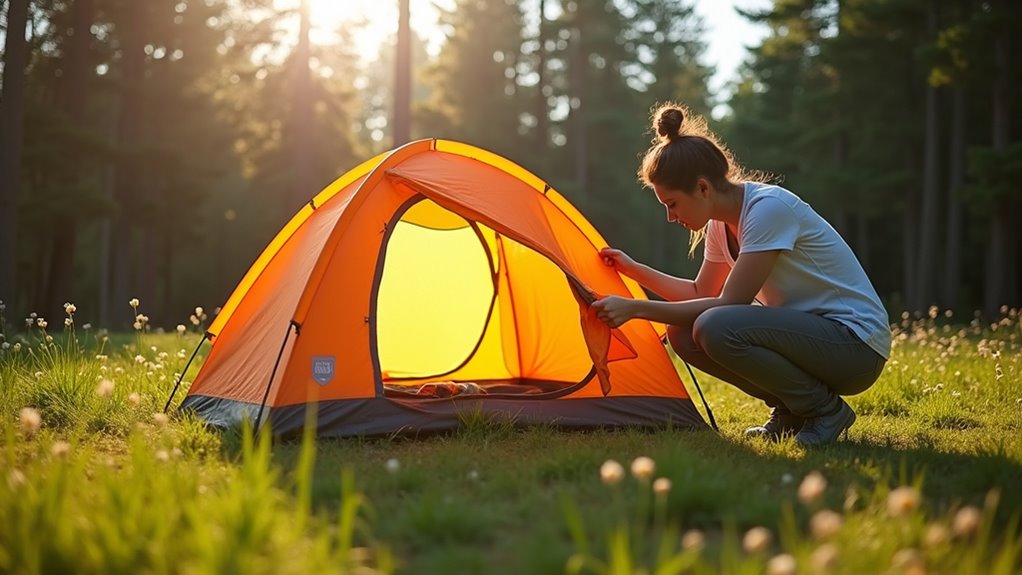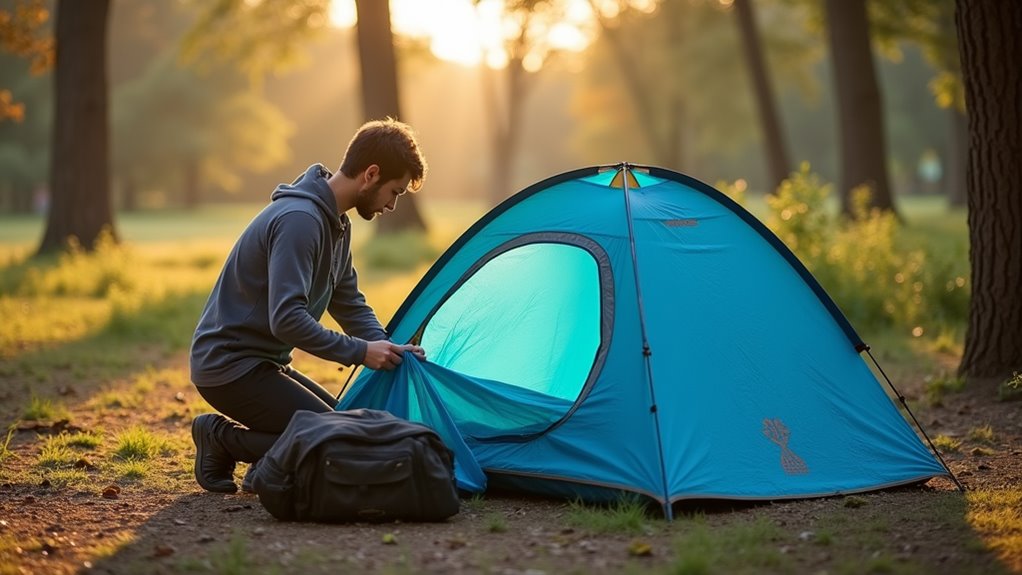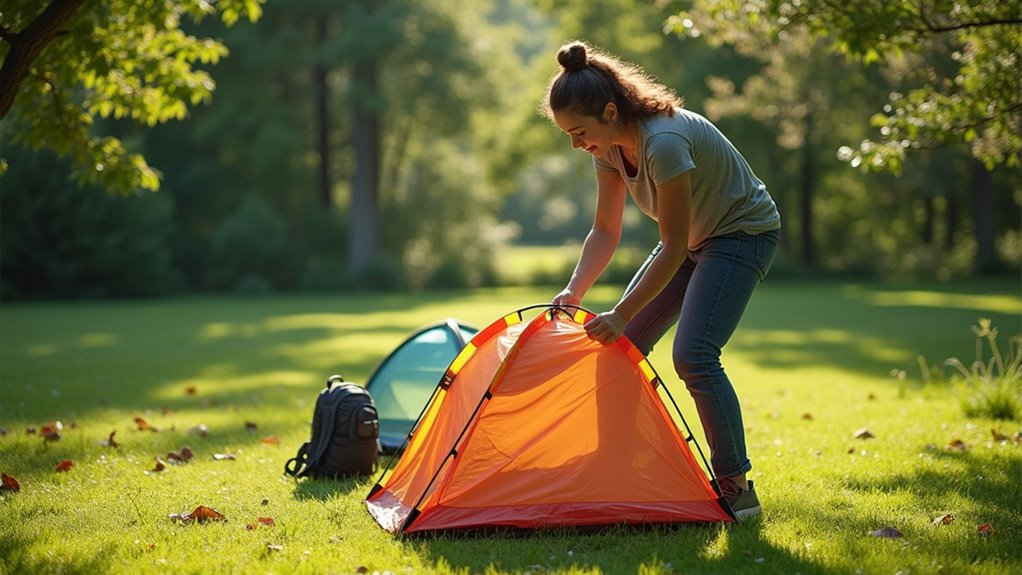How To Close A Pop Up Tent
This post contains affiliate links. As an Amazon Associate, we earn from qualifying purchases.
To close a pop-up tent, begin by lowering the structure carefully and releasing the tension. Next, disengage the locks, fold the frame evenly, and neatly fold the fabric toward the center before storing it properly. Further details and step-by-step instructions will be provided below for those who want a more thorough explanation.
Essential Facts in 30 Seconds
- Lower the tent frame and release tension by turning the crank counterclockwise.
- Unlock thumb locks on each leg and slide legs down slowly.
- Fold fabric gently, shaking out wrinkles and tucking in edges.
- Twist and loop the tent by holding corners together for stability.
- Secure folded tent with straps or ties and store in a dry place.
Loosening and Lowering the Tent Structure

Lower your pop-up tent carefully to avoid damage.
Turn the crank or tightening part counterclockwise. This releases tension at the top. Push up gently on the corner caps. This eases pressure before you unlock the locks. This step stops the corners from breaking during collapse. Make sure to remove any stakes before starting to prevent any accidents.
Unlock the thumb locks on each leg. Slide the legs down slowly. Do this on all four corners one by one. This keeps the tent balanced and safe.
Push the truss and frame bars up and inward. This helps the frame shrink easily. Following the steps in removing stakes will ensure a smoother process when closing your tent.
Follow these steps to protect your tent and make lowering easy. Take your time. Work with care. Your tent will last longer.
Folding the Tent Frame and Legs
Lower the legs of your pop-up tent carefully after releasing the pressure. Unlock the thumb locks or release pins on each leg. Slide the legs down slowly to protect the locking parts. Do this on all four corners for a smooth fold.
Push the frame sides inward or upward with even pressure. This stops the frame from bending. Fold the top truss bars by pushing upward to ease tension. Watch out for spring-loaded joints. Avoid folding the frame from the center. Use the angled sides instead for a natural fold.
Hold pairs of legs or frame sides and squeeze gently. Collapse the tent frame into a small, compact shape. Make sure to collapse the tent using the proper technique to prevent damage. Keep control to avoid sudden snaps. This method makes folding easy and safe every time. Remember to fold the tent properly to ensure it fits snugly for storage.
Flattening and Preparing the Fabric

Start by shaking or pressing the fabric gently to remove wrinkles. Close all mesh doors and windows first. This keeps the fabric and tent stable.
Pull out sunshades and mesh flaps fully flat. This stops creases from forming.
Fold the fabric sides neatly toward opposite ends. Tuck the edges inside while lowering the tent parts. Avoid bunching the fabric. Don’t fold in an accordion style. Fold corners at a 45-degree angle toward the center. Remember to check for belongings before fully closing the tent to ensure nothing is left behind.
Walk around the tent to smooth and adjust fabric evenly. Keep folds flat and neat. This prevents creases and protects the fabric. Proper folding helps your tent last longer and stay in good shape. Additionally, ensure the tent is clean and dry to prevent mildew before packing it away.
Forming the Tent Into Loops or Circular Shapes
Fold the tent fabric neatly. Lay the tent flat with the open side up. Remove all stakes first.
Hold two nearby rounded corners together. Squeeze them to make a smaller loop. Push the loops down toward the center. Make sure they overlap correctly. Twist the loops slightly to lock them in place. This keeps the tent stable. Additionally, ensure the tent is clean and dry before packing to prevent mold and damage. A well-packed tent also enhances overall outdoor experience by making it easy to transport.
Some problems may come up. Corners may not line up well. The tent might pop open. Change the tent’s position to fix this. Use gentle pressure when folding. Support the frame to avoid damage.
Practice helps a lot. You’ll fold faster and better. The tent will stay neat and easy to carry. This simple method saves space and time.
Final Folding and Storage

Final folding and storing your pop-up tent keeps it strong and ready to use. First, take out all stakes and guylines. Open doors and windows to let air out. Clean the tent to stop mold from growing. Lay it flat on a clean surface. Remember to visualize hugging the tent as you fold it to make the process easier.
| Step | Tips |
|---|---|
| Collapse Tent | Press the top panel down gently. Fold poles together. |
| Secure Fold | Use the strap or Velcro ties that came with the tent. |
| Store Properly | Keep the tent in a cool, dry place. Make sure it is dry. |
Additionally, remember to organize poles and stakes to prevent damage and ensure easy transport. Put the folded tent back in its carry case to keep dust away. Do not put heavy things on top of it. Good care helps your tent last longer. Air it out often and check for repairs. Simple steps protect your tent for many camping trips.
Frequently Asked Questions
How Long Does It Typically Take to Close a Pop-Up Tent?
Closing a pop-up tent usually takes 30 seconds to 3 minutes. Experience helps you close it faster. Simple tents close quicker than complex ones. Practice cuts your closing time a lot. Most people find closing easier than setting up. Don’t rush; take your time to fold it right. This keeps the tent safe and ready for next use.
Can I Close a Tent Alone, or Do I Need a Partner?
Closing a tent alone is possible. Many people do it every day. Small and medium tents close easily by one person. Larger tents need more hands to fold and pack quickly. Practice helps a lot. Careful folding and rolling saves space and time. Using simple tools like clips and ties makes the job easier. Safety matters too. Avoid rushing to prevent damage or injury. Teamwork speeds up closing but is not always necessary. Many campers close tents solo without trouble. Try it yourself and see how smooth it gets!
What Tools Do I Need for Closing a Pop-Up Tent?
Basic tools like pliers, a hammer, and zip ties help keep your tent in good shape. A crank handle makes opening and closing the pop-up tent easy and smooth. A stake puller can help remove stakes quickly, speeding up the process. Using these tools saves time and reduces damage to your tent. Simple gear makes your camping experience better and stress-free.
Is It Safe to Close a Tent in Windy Conditions?
Closing a tent during strong wind can be dangerous. Winds over 30 mph can shake and damage your tent. Secure the tent with strong stakes and ropes first. Try to face the tent door away from the wind. This helps keep the tent stable and stops it from collapsing. If the wind gets worse, take the tent down to stay safe. Never risk injury by leaving a tent in very strong wind. Safety comes first on any camping trip.
How Can I Prevent Damage While Closing My Pop-Up Tent?
Secure the stakes tightly to keep the tent stable. Check the fabric and remove any dirt or rocks before folding. Fold the frame slowly and carefully to avoid tears or breaks. Avoid quick or sharp movements while closing. Take your time to protect the tent and make it last longer. Clean and dry the tent before packing to stop mold and damage. Small steps like these help keep your tent safe and ready for the next use.
Conclusion
Closing a pop-up tent is easy with practice. Start by loosening the frame gently. Next, fold the frame carefully to avoid breaking it. Flatten the fabric so it fits into the storage bag. This method saves space and protects the tent. Many campers use this way to keep their tents neat and ready. Try it a few times, and it will feel simple. Your tent stays safe and lasts longer. Ready for your next trip!
